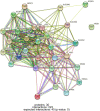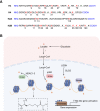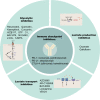Research progress of abnormal lactate metabolism and lactate modification in immunotherapy of hepatocellular carcinoma
- PMID: 36686771
- PMCID: PMC9853001
- DOI: 10.3389/fonc.2022.1063423
Research progress of abnormal lactate metabolism and lactate modification in immunotherapy of hepatocellular carcinoma
Abstract
Tumors meet their energy, biosynthesis, and redox demands through metabolic reprogramming. This metabolic abnormality results in elevated levels of metabolites, particularly lactate, in the tumor microenvironment. Immune cell reprogramming and cellular plasticity mediated by lactate and lactylation increase immunosuppression in the tumor microenvironment and are emerging as key factors in regulating tumor development, metastasis, and the effectiveness of immunotherapies such as immune checkpoint inhibitors. Reprogramming of glucose metabolism and the "Warburg effect" in hepatocellular carcinoma (HCC) lead to the massive production and accumulation of lactate, so lactate modification in tumor tissue is likely to be abnormal as well. This article reviews the immune regulation of abnormal lactate metabolism and lactate modification in hepatocellular carcinoma and the therapeutic strategy of targeting lactate-immunotherapy, which will help to better guide the medication and treatment of patients with hepatocellular carcinoma.
Keywords: hepatocellular carcinoma; immune regulation; immunotherapy; lactate metabolism; lactylation.
Copyright © 2023 Xu, Hao, Ren, Xu, Liu, Song and Wang.
Conflict of interest statement
The authors declare that the research was conducted in the absence of any commercial or financial relationships that could be construed as a potential conflict of interest.
Figures






Similar articles
-
Lactate-Lactylation Hands between Metabolic Reprogramming and Immunosuppression.Int J Mol Sci. 2022 Oct 8;23(19):11943. doi: 10.3390/ijms231911943. Int J Mol Sci. 2022. PMID: 36233246 Free PMC article. Review.
-
Lactate: The Mediator of Metabolism and Immunosuppression.Front Endocrinol (Lausanne). 2022 Jun 9;13:901495. doi: 10.3389/fendo.2022.901495. eCollection 2022. Front Endocrinol (Lausanne). 2022. PMID: 35757394 Free PMC article. Review.
-
Lactate and Lactylation: Dual Regulators of T-Cell-Mediated Tumor Immunity and Immunotherapy.Biomolecules. 2024 Dec 21;14(12):1646. doi: 10.3390/biom14121646. Biomolecules. 2024. PMID: 39766353 Free PMC article. Review.
-
Regulatory role and therapeutic prospect of lactate modification in cancer.Front Pharmacol. 2025 Feb 17;16:1508552. doi: 10.3389/fphar.2025.1508552. eCollection 2025. Front Pharmacol. 2025. PMID: 40034817 Free PMC article. Review.
-
Unveiling lactylation modification: A new hope for cancer treatment.Biomed Pharmacother. 2025 Mar;184:117934. doi: 10.1016/j.biopha.2025.117934. Epub 2025 Feb 21. Biomed Pharmacother. 2025. PMID: 39986235 Review.
Cited by
-
The Role of Metabolic Reprogramming in the Tumor Immune Microenvironment: Mechanisms and Opportunities for Immunotherapy in Hepatocellular Carcinoma.Int J Mol Sci. 2024 May 21;25(11):5584. doi: 10.3390/ijms25115584. Int J Mol Sci. 2024. PMID: 38891772 Free PMC article. Review.
-
The relationship and clinical significance of lactylation modification in digestive system tumors.Cancer Cell Int. 2024 Jul 15;24(1):246. doi: 10.1186/s12935-024-03429-8. Cancer Cell Int. 2024. PMID: 39010066 Free PMC article. Review.
-
Al-Hijamah (Prophetic Wet Cupping Therapy) is a Novel Adjuvant Treatment for Viral Hepatitis That Excretes Viral Particles and Excess Ferritin Percutaneously, Synergizes Pharmacotherapy, Enhances Antiviral Immunity and Helps Better HCC Prevention and Treatment: A Novel Evidence-Based Combination with Prophetic Medicine Remedies.J Hepatocell Carcinoma. 2023 Sep 13;10:1527-1546. doi: 10.2147/JHC.S409526. eCollection 2023. J Hepatocell Carcinoma. 2023. PMID: 37727876 Free PMC article.
-
Role of lactate and lactate metabolism in liver diseases (Review).Int J Mol Med. 2024 Jul;54(1):59. doi: 10.3892/ijmm.2024.5383. Epub 2024 May 24. Int J Mol Med. 2024. PMID: 38785162 Free PMC article. Review.
-
Serum proteomic and metabolomic profiling of hepatocellular carcinoma patients co-infected with Clonorchis sinensis.Front Immunol. 2025 Jan 7;15:1489077. doi: 10.3389/fimmu.2024.1489077. eCollection 2024. Front Immunol. 2025. PMID: 39840062 Free PMC article.
References
Publication types
LinkOut - more resources
Full Text Sources

